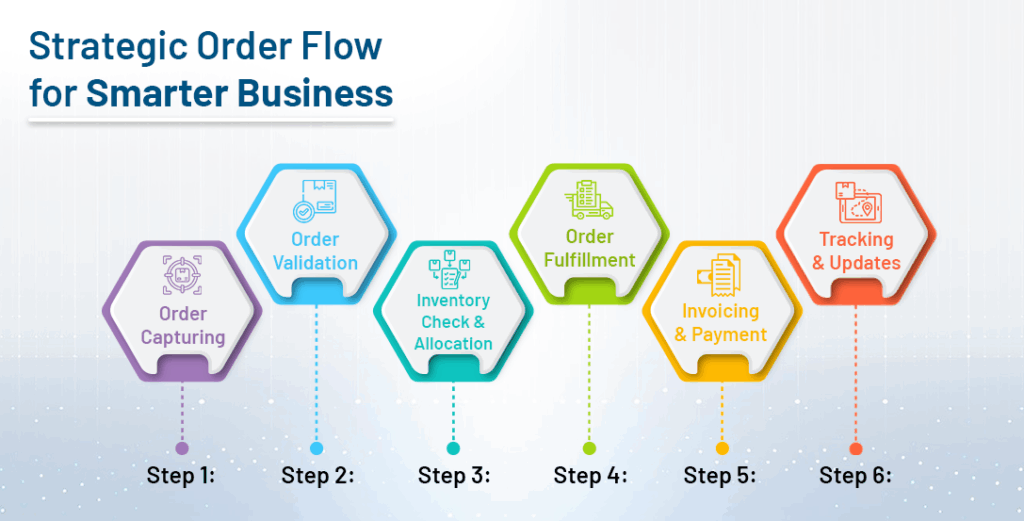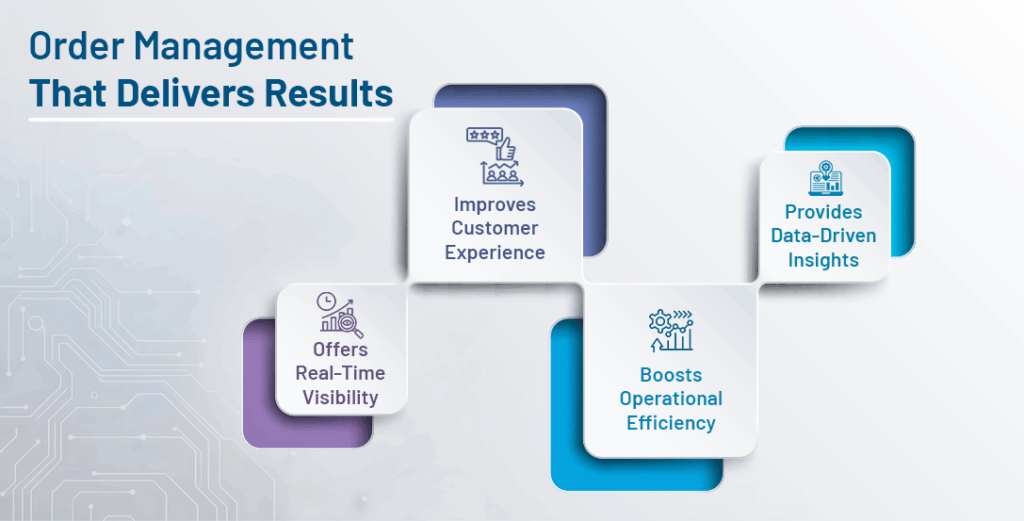
What happens when your order management is not properly executed?
Missed deliveries, stock mismatches, delayed invoicing—these aren’t just operational issues; they’re lost revenue, broken trust, and customer churn. Poor order management quietly undermines your sales efforts and impacts your growth engine.
In a fast-paced market, every delayed order is a competitor’s opportunity. This guide explores why mastering order management is no longer optional—and how getting it right can transform your sales and distribution into a growth powerhouse.
Order Management: Your Competitive Edge
Order management is the backbone of every successful sales and distribution operation. It’s the seamless orchestration of receiving, processing, tracking, and fulfilling customer orders from start to finish. From the moment a customer places an order to when it’s delivered (and even handled post-sale), order management ensures everything runs like clockwork.
In the world of sales and distribution, this process is even more critical. With multiple touchpoints—sales reps, inventory systems, warehouses, and logistics—order management is what ties it all together. A single breakdown, whether it’s a stockout, delivery delay, or miscommunication, can lead to lost sales and frustrated customers.
Mastering order management is not just about getting the product to the customer; it’s about eliminating friction, improving accuracy, and creating a smooth, efficient supply chain that powers business growth.
Decoding the Order Management Process
Order management is the backbone of a smooth sales and distribution operation. It’s a finely tuned system where each step depends on the one before it, ensuring everything flows seamlessly from order capture to delivery. Every action, from inventory checks to fulfillment, plays a crucial role in keeping customers happy and operations running smoothly.

Order Capture: The First Step to Success:
The journey begins when an order is placed. This can happen in a variety of ways—sales reps capturing orders during store visits, customers purchasing through e-commerce platforms, or even orders made directly at retail locations. For instance, a sales rep might take an order from a retail partner during a face-to-face meeting, inputting it into the system on the spot. This ensures orders are immediately captured, preventing any manual delays.
Order Validation: Ensuring Accuracy
Once the order is captured, the next step is validation. The system checks critical factors like product availability, customer credit status, pricing agreements, and discounts. Think of it like a double-check: imagine a retailer placing a large order for a popular item. The system confirms whether the requested quantity is available and if any special pricing conditions are met. If everything checks out, the order moves forward.
Inventory Check and Allocation: Confirming Stock Availability
This step ensures that the items ordered are in stock, either in central warehouses or local distribution centers. For example, if a customer orders 50 units of a product, the system will check various warehouse locations for availability. If inventory is low, the system might trigger a backorder or suggest an alternative product to prevent delays.
Order Fulfillment: The Core of Delivery
Now comes the exciting part—fulfillment. This involves picking the right products, packing them, and getting them shipped out to the customer. Warehouse staff, logistics providers, and the sales team work together to ensure the products are delivered on time and as promised. Picture a scenario where a distributor places an order for a batch of items for a retail store. The warehouse team carefully selects packages and ships the items, ensuring everything is delivered on schedule.
Invoicing and Payment: Closing the Loop
Once the order is fulfilled, invoicing comes next. The payment terms can vary—prepaid, credit-based, or cash on delivery. For example, a customer who ordered items with a credit facility may receive an invoice with the agreed-upon payment terms. Integration with financial systems ensures smooth tracking and prevents billing errors, making sure businesses get paid on time and accurately.
Tracking and Updates: Keeping Everyone in the Loop
Throughout the order journey, stakeholders—including customers, distributors, and warehouse teams—are kept informed. Tracking details are updated in real-time, letting everyone know exactly where the order is at each stage. Imagine a customer waiting for a high-demand product. By receiving status updates, they can plan accordingly, knowing exactly when to expect their delivery.
Returns and Feedback: The Final Step
Not every order is perfect, and sometimes returns are necessary due to reasons like damages, incorrect items, or other issues. A streamlined order management system makes returns easy to process, ensuring smooth reverse logistics. For example, if a customer receives the wrong product, they can quickly initiate a return, and the system handles the logistics of getting the product back to the warehouse for proper handling. By maintaining a well-organized, seamless process from order capture to delivery and beyond, businesses can improve customer satisfaction, reduce errors, and create a more efficient supply chain. After all, it’s not just about fulfilling orders—it’s about creating a smooth, positive experience at every touchpoint.
Why is Order Management Critical?
Order management is far more than just a back-end process—it’s a cornerstone of effective sales and distribution strategies. When done right, it can streamline operations, enhance customer relationships, and contribute directly to your bottom line. Let’s explore why order management is essential for businesses:

Optimized Customer Experience:
Accurate and timely order fulfillment directly translates to customer satisfaction. When orders are delivered as promised, it builds trust and encourages repeat business. On the flip side, delays or errors can damage customer relationships and hinder future sales opportunities.Comprehensive Visibility and Control:
A centralized order management system provides real-time visibility into inventory levels, order status, and delivery timelines. This real-time data allows sales leaders to make informed decisions, manage stock levels effectively, and proactively address any challenges in the supply chain, ensuring smooth operations.Operational Efficiency through Automation:
By automating key tasks such as inventory checks, order processing, and invoicing, businesses can significantly reduce manual errors and eliminate redundant processes. This boosts efficiency, enabling sales and distribution teams to focus on high-priority strategic activities rather than managing operational bottlenecks.Actionable Data-Driven Insights:
An effective order management system generates valuable data on sales trends, peak demand periods, and common issues. This insight allows businesses to fine-tune product offerings, adjust pricing strategies, and design targeted promotions, leading to more informed decision-making and improved profitability.Scalability for Long-Term Growth:
As your business grows, so does the complexity of managing orders across a larger distribution network. A robust order management system can scale seamlessly, ensuring that your operations continue to run smoothly, even as order volume and product offerings increase. This scalability ensures that your business can meet rising customer demands without compromising on service quality.
Improve Order Management with Recibo
Order management can often feel like doing multiple tasks at the same time—capturing orders, managing inventory, ensuring timely deliveries. But what if there was a way to make it all run like clockwork? That’s where Recibo comes in.
With Recibo, sales reps can instantly capture orders on their mobile app, syncing everything seamlessly with backend systems to ensure no mistakes. The system updates inventory in real-time, so there’s no risk of promising items that aren’t in stock—and if something is unavailable, the platform quickly suggests alternatives.
But that’s not all. Recibo also optimizes delivery routes, making sure your goods are getting to the right place at the right time.
Sales representatives can also manage promotions and schemes effortlessly with Recibo. Whether it’s a special discount or an exclusive offer, everything’s right at their fingertips, improving compliance and driving more sales. And with Recibo’s detailed reporting and analytics, businesses gain insights to streamline operations, enhance forecasting, and make smarter, data-driven decisions.
In short, Recibo doesn’t just manage orders—it transforms the entire order-to-cash process, making it more efficient, accurate, and agile for today’s fast-paced business world.
Bottom Line
Order management isn’t just about keeping customers happy—it’s a fundamental pillar of business growth, operational efficiency, and customer loyalty. Effective order management allows businesses to meet demand, avoid stockouts, streamline fulfillment, and maintain strong relationships with partners and customers.
To stay competitive, businesses must transition from outdated, manual order systems to more intelligent, automated solutions. Platforms like Recibo not only simplify the order-to-cash cycle but also offer valuable insights that drive continuous improvement. By embracing technology-driven order management, companies can unlock new efficiencies, minimize friction, and ensure that every order flows smoothly from start to finish.
Ready to improve your order management with Recibo?
Book a Demo